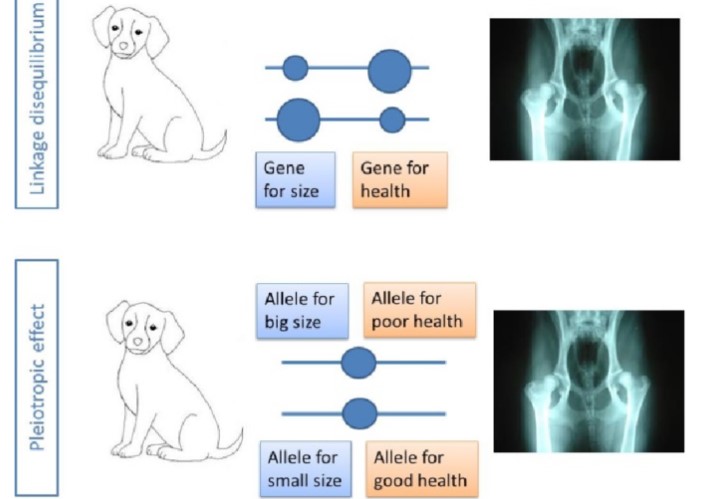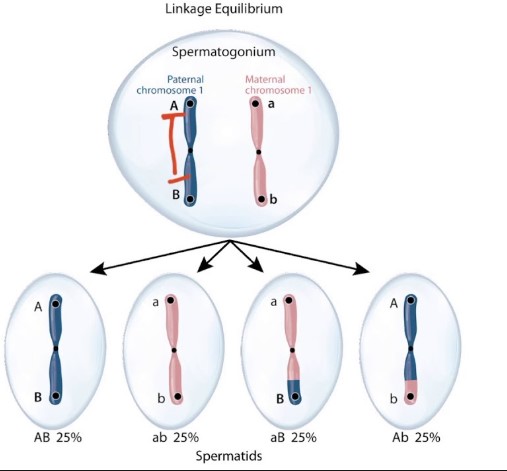Genetic linkage and linkage disequilibrium are cornerstone concepts in the field of genetics, each playing a pivotal role in our understanding of hereditary patterns and the mapping of genetic diseases. These mechanisms, while often discussed in tandem, have distinct definitions and implications for both researchers and medical professionals. At their core, they help explain how certain traits or conditions are passed from one generation to the next and are crucial for anyone looking to grasp the complexities of genetics.
Genetic linkage refers to the tendency of genes that are close to each other on a chromosome to be inherited together during meiosis, the process that produces reproductive cells. On the other hand, linkage disequilibrium describes the non-random association of alleles at two or more loci, not necessarily on the same chromosome. It can arise from historical mutations, genetic drift, or population structure and has profound implications for mapping genes associated with diseases.
While both concepts deal with the relationship between genes, their distinctions are vital for the field of genetics. Genetic linkage provides a framework for understanding how traits are co-inherited, and linkage disequilibrium offers insights into how gene variants at different locations are associated with each other and with various diseases. These concepts not only enrich our understanding of genetic inheritance but also enhance our ability to identify and combat genetic disorders.

Genetic Basics
DNA and Genes
The Structure of DNA
DNA, or Deoxyribonucleic Acid, is the blueprint for all living organisms. It’s composed of two long strands forming a double helix. These strands are made up of nucleotides, each containing a phosphate group, a sugar molecule (deoxyribose), and a nitrogenous base (adenine, thymine, cytosine, or guanine). The sequence of these bases encodes genetic information.
Role of Genes in Heredity
Genes are segments of DNA that carry instructions for making proteins, the building blocks of our bodies. They determine traits such as eye color, height, and predisposition to certain diseases. Through heredity, genes are passed down from parents to offspring, ensuring that species retain their distinctive characteristics across generations.
Chromosomes
Definition and Function
Chromosomes are long, organized structures of DNA and protein found in cells. They carry genetic information crucial for growth, development, and functioning. During cell division, chromosomes ensure DNA is accurately copied and distributed to daughter cells, a critical process for reproduction, growth, and repair.
Chromosomal Composition
Each chromosome is composed of a single, tightly coiled DNA molecule and associated proteins that help maintain its structure and control gene activity. Humans have 23 pairs of chromosomes, half inherited from each parent, making up a total of 46.
Genetic Linkage
Definition
Genetic linkage is the tendency of genes located close together on the same chromosome to be inherited together. This concept is fundamental to understanding genetic inheritance patterns.
Explanation of Genetic Linkage
When two genes are close together on a chromosome, they are less likely to be separated during recombination, a process that occurs during meiosis. This means they are more likely to be passed on as a pair to the next generation.
Discovery
Historical Background
The principle of genetic linkage was first discovered by Thomas Hunt Morgan in the early 20th century. Morgan’s work with fruit flies demonstrated that genes on the same chromosome behaved differently than Mendel’s laws of inheritance would suggest, leading to the understanding of linkage.
Principles
Mechanisms of Genetic Linkage
Genetic linkage occurs because of the physical proximity of genes on a chromosome. During meiosis, chromosomes undergo recombination, where they exchange segments. Genes closer together are less likely to be separated by this exchange, thus are said to be linked.
Factors Affecting Linkage
Distance Between Genes
The closer two genes are on a chromosome, the greater their linkage. This is because there’s less chance for a recombination event to occur between them.
Recombination Frequency
Recombination frequency is used to measure the distance between genes. It is the percentage of offspring where recombination has occurred between two genes, indicating their physical distance on a chromosome.
Linkage Disequilibrium
Definition
Linkage disequilibrium (LD) is the non-random association of alleles at two or more loci, not necessarily on the same chromosome. It measures how frequently alleles occur together more or less often than expected by chance.
Explanation of Linkage Disequilibrium
LD occurs when alleles at different loci are inherited together more or less often than if their transmission was independent. This can reveal important genetic associations and population history.
Causes
Mutation
Mutations can introduce new alleles into a population, affecting LD when these alleles are inherited with others more frequently.
Genetic Drift
Genetic drift refers to changes in allele frequencies due to random chance. It can lead to increased LD if certain allele combinations become more common purely by chance.
Population Structure
Population structure, such as when populations are subdivided or partially isolated, can lead to varying allele frequencies across groups, influencing LD.
Measurement
Statistical Methods
LD is measured through statistical methods that compare the observed frequency of allele combinations to what would be expected if alleles were inherited independently. The D’ statistic and r^2 are common measures used.
Importance
In Disease Mapping
LD is crucial in mapping genes associated with diseases. By identifying alleles that are inherited together with disease traits, researchers can locate the responsible genes more efficiently.
In Evolutionary Biology
LD provides insights into evolutionary processes and population history. It helps in understanding how populations have adapted over time and how genetic diversity is distributed.

Key Differences
Distinctions in Definition and Significance
Genetic linkage and linkage disequilibrium (LD) are fundamental concepts in genetics with distinct definitions and implications. Genetic linkage is the phenomenon where genes close to each other on the same chromosome are inherited together more often than not. This concept is crucial for understanding how traits are co-inherited. On the other hand, linkage disequilibrium refers to the non-random association of alleles at two or more loci, which can be on the same or different chromosomes. LD is especially significant in the study of population genetics and in identifying genetic variants associated with diseases.
Practical Implications
The practical implications of these concepts are vast. Genetic linkage assists in mapping genetic traits and is fundamental in Mendelian genetics, providing insights into the physical arrangement of genes on chromosomes. Linkage disequilibrium, however, is more commonly used in association studies to identify genetic variants that contribute to complex diseases. It has become a powerful tool in genome-wide association studies (GWAS), enabling researchers to study the genetics of diseases that do not follow simple Mendelian inheritance patterns.
Genetic Mapping vs. Population Genetics
Role in Genetic Mapping
Genetic linkage plays a pivotal role in genetic mapping by helping scientists determine the location of genes on chromosomes. This process is crucial for identifying genes responsible for inherited diseases. Through the use of linkage analysis, researchers can pinpoint the exact position of a gene relative to a known marker, making it easier to isolate and study specific genes.
Role in Population Genetics
Linkage disequilibrium is invaluable in population genetics, offering insights into the historical and evolutionary dynamics of populations. LD patterns can reveal how populations have migrated, expanded, or contracted over time. Additionally, LD is used to study natural selection and genetic drift, as certain allele combinations can increase or decrease in frequency due to these evolutionary pressures.
Case Studies
Genetic Linkage
Historical Examples
One of the earliest and most notable examples of genetic linkage was discovered by Thomas Hunt Morgan and his team in the early 20th century. Through their work with fruit flies (Drosophila melanogaster), they observed that certain traits, such as eye color and wing size, were inherited together more often than would be expected by chance. This groundbreaking research laid the foundation for the modern understanding of genetic linkage and chromosomal inheritance.
Linkage Disequilibrium
Recent Studies
A recent study that highlights the importance of linkage disequilibrium is the identification of genetic variants associated with type 2 diabetes. Researchers used LD to find SNPs (single nucleotide polymorphisms) that were non-randomly associated with the disease. This approach has led to significant advancements in understanding the genetic basis of complex diseases, enabling targeted research into treatments and interventions.
Applications
Medical Research
Identifying Genetic Diseases
Both genetic linkage and linkage disequilibrium are crucial in the field of medical research for identifying the genetic underpinnings of diseases. Genetic linkage analysis has been instrumental in pinpointing genes responsible for rare, monogenic disorders, such as cystic fibrosis and Duchenne muscular dystrophy. Meanwhile, linkage disequilibrium is utilized extensively in GWAS to find associations between specific alleles and common, complex diseases like diabetes, cancer, and heart disease. These studies have opened up new avenues for genetic testing, personalized medicine, and the development of novel therapeutic strategies.
Evolutionary Studies
Tracing Evolutionary History
Linkage disequilibrium is also a key tool in evolutionary biology, providing insights into the ancestral relationships and migration patterns of different populations. By analyzing the pattern of LD across different groups, scientists can infer historical admixture events and the movement of human populations across the globe. Similarly, studies of genetic linkage in various species contribute to our understanding of evolutionary mechanisms and how genetic diversity is generated and maintained within populations.
Frequently Asked Questions
What is genetic linkage?
Genetic linkage is the phenomenon where genes located physically close to each other on the same chromosome tend to be inherited together. This concept is pivotal in understanding how traits are passed down through generations and is a fundamental principle of genetics that aids in genetic mapping and studying hereditary diseases.
How does linkage disequilibrium occur?
Linkage disequilibrium occurs when there is a non-random association of alleles at different loci that are not necessarily on the same chromosome. This can result from various factors, including mutation, genetic drift, and the structure of populations, leading to alleles being inherited together more or less often than expected by chance alone.
Why is understanding genetic linkage and linkage disequilibrium important?
Understanding these concepts is crucial for genetic research and medical applications, including the mapping of genes related to diseases, the study of evolutionary biology, and the development of new medical treatments. They allow scientists to predict how traits and conditions may be passed on to future generations and to identify the genetic basis of complex diseases.
How do genetic linkage and linkage disequilibrium differ?
While both relate to the inheritance of genes, genetic linkage is about the co-inheritance of genes on the same chromosome, whereas linkage disequilibrium involves the non-random association of alleles at different loci. The key difference lies in their occurrence and the implications for the study of genetics and disease.
Conclusion
In conclusion, genetic linkage and linkage disequilibrium are fundamental concepts that offer profound insights into the patterns of genetic inheritance and the complexities of human genetics. Their study not only furthers our understanding of how traits and diseases are passed down through generations but also plays a crucial role in the development of genetic testing and therapies. By elucidating the nuances of these genetic phenomena, researchers continue to unlock the mysteries of the genome, paving the way for advancements in medical science and healthcare.
These concepts highlight the intricacies of genetics and the importance of precise scientific research. As we advance in our understanding and technologies, the implications of genetic linkage and linkage disequilibrium in disease mapping, evolutionary studies, and medical research become even more significant. It’s through the continued exploration of these areas that we can hope to better understand our genetic blueprint and improve health outcomes for future generations.

